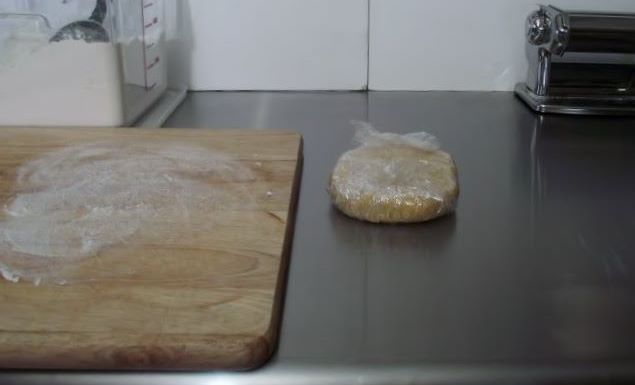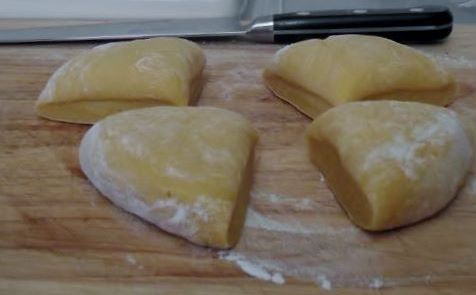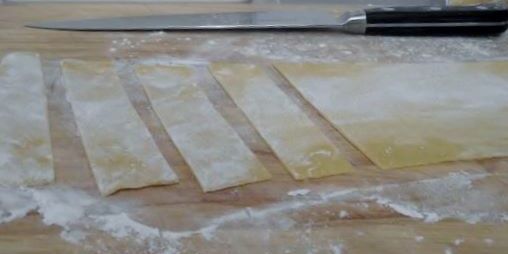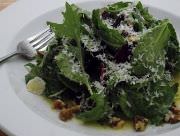Leftover Recipe For Pulled Pork Pasta

Simple and delicious leftover recipe for pulled pork pasta using homemade papperdelle pasta and pulled pork shoulder.
Leftovers
Chefs love leftovers, they allow you to use your creativity by taking a dish, or component of a dish, and turning it into something completely different.
Not only that, but, let's say I order in 30 pounds of pork butt to make ravioli. I use up 20 pounds of the meat in the raviolis and I sell those out. I'm left with 10 pounds of meat. Because pasta dishes are usually a low cost high price menu item there is a good chance that I've already covered my costs with the raviolis. That means that anything I do with the remainder of the meat is profit.
Take the recipe below for example. I started out making pulled pork for sandwiches. All I really did was braise the pork with aromatic vegetables and herbs and some chicken stock. When it was done I shredded the pork and made sandwiches for dinner, simple.
I started thinking about what to do with the leftovers and I decided that I would make pasta and use the meat and liquid as a sauce for the pasta. I added a little smoked cheddar and some green onions and we had an entirely different dish from the same pork.
I made papperdelle pasta because the flat wide noodles are ideal for a shredded meat sauce.
Leftover Recipe For Pulled Pork Pasta
Leftovers are more about utilizing leftover ingredients or components rather than being a hard and fast recipe with set ingredients.
Pulled Pork Pasta
- Yield 3 servings
- Prep Time 45 minutes
- Cook Time 15 minutes
Ingredients
- Pulled Pork, shredded - recipe follows
- Papperdelle pasta - recipe follows
- Kosher salt to taste
- 1 bunch green onions, sliced on a bias
- 2 to 3 ounces smoked cheddar cheese, shredded
- 2 to 3 ounces pepper jack cheese, shredded
Method
- Add the shredded pork and some of the braising liquid to a small saucepan and heat over low heat. When the meat is hot and the liquid has reduced by about half, remove from heat and set aside.
- Meanwhile, bring a large pot of water to a rolling boil. Add salt and return to a boil. (Water for pasta should taste like the ocean.) Add the pasta to the water gently but quickly. Return to a boil and continue until the pasta is cooked through. Remember al dente is for dried pasta only. If you cook fresh pasta al dente it has a raw eggy taste.
- When the pasta is done drain it through a colander, reserving about a cup of the pasta water.
- Add the pasta back to the pot. Pour the meat and braising liquid over the pasta. Add about two thirds of the green onions and about three quarters of the cheese to the pot. Toss the pasta gently with tongs until all of the pasta is coated and the ingredients are distributed evenly. If the pasta seems too dry add some of the pasta water to the pot. The goal is to make a sauce out of the braising liquid, pasta water, and the cheese.
- Arrange pasta on 3 plates and top with a sprinkle of the remaining cheese and green onions.
Pulled Pork Shoulder
This is a great recipe for pulled pork. The flavors are nicely balanced with a little bit of heat. Because there are no flavors that put it into one specific cuisine it is very versatile.
Yo can add barbecue sauce to make barbecued pulled pork sandwiches, or add teriyaki and make pulled pork over rice. You could also make a sauce with lemon and garlic and serve it over a simple mixed greens salad.

Once the meat has cooled to the touch remove the meat to a sheet pan and shred it into pieces using forks or your hands.

When you have enough meat for the sauce, about 4 ounces or 115 grams, place it in a bowl, and pour enough of the braising liquid over it to cover the meat.

Add the shredded meat to the liquid and set aside until ready to serve, or refrigerate for later use.
Ingredients
- 1 4 pound pork shoulder or pork butt, bone in or boneless
- Canola oil for searing
- 1 yellow onion, quartered
- 3 garlic cloves, peeled
- 1 pasilla chili pepper, seeded and rough chopped
- 1 green bell pepper, seeded and rough chopped
- White wine for de-glazing
- 2 stalks celery, cut into 1 inch lengths
- 2 bay leaves
- 7 to 8 sprigs thyme
- 1 to 2 teaspoons black peppercorns, or to taste
- Kosher salt, to taste
- Chicken stock
Method
- Preheat oven to 225° F
- Cut the pork into 3 to 4 smaller pieces of roughly equal size. Brown the pork, over medium heat, 1 or 2 pieces at a time, on all sides, in a large stock pot. Remove the pieces to a plate and set aside.
- Add the onion, garlic, chili pepper, and bell pepper to the pot and cook until the onion begins to caramelize. Add a few splashes of white wine to deglaze the pot. Give it a stir and allow the wine to cook down for a minute.
- Add the celery, bay leaves, thyme, and peppercorns and stir to combine and coat everything.
- Add the pieces of pork butt back into the pot on top of everything else. Add enough chicken stock to bring the liquid halfway up the sides of the pork pieces. Bring the liquid to a boil, cover the pot, and transfer to the preheated oven.
- Cook until the pork is fork tender, about 2 hours. Remove the pot from the oven, leave the lid on the pot, and allow the pork to cool completely, in its braising liquid.
- If you remove the meat before it is cool it will dry out and be like jerky, not nice, not pleasant.
- Once the meat has cooled to the touch remove the meat to a sheet pan and set aside.
- Strain the braising liquid through a fine mesh strainer and add the liquid back to a clean pot.
- Shred the meat into pieces using forks or your hands. Add the shredded meat back to the liquid and set aside until ready to serve, or refrigerate for later use.
Papperdelle Pasta
Homemade pasta is so easy and simple to make and tastes so much better than anything you're going to get in a grocery store. I really hope you get in the habit of making fresh pasta for yourself and your family and friends.

Form the dough into a disk about an inch thick. Wrap in plastic wrap and rest on the counter.

To roll the pasta set up your pasta machine and section the dough into 4 pieces. While working one piece at a time keep the remaining pieces covered with a damp cloth to prevent drying out.

As you complete a section of dough lay the dough on a floured cutting board and slice the dough crosswise into 1 inch thick strips.

Put a piece of parchment on a sheet pan and flour the paper. Arrange the pieces of pasta in a single layer on the paper. When a layer is full cover it with another piece of parchment, flour it, and continue until all the pasta is rolled out and cut.
Ingredients
- 125 grams all purpose flour
- 125 grams semolina
- 2 whole eggs
- 3 egg yolks
Method
- Combine the flours into the bowl of your stand mixer and whisk to thoroughly combine. Whip the egg yolks and whole eggs together and pour into the flour mixture. Using the paddle attachment mix until a tight dough begins to form. Change the paddle for the dough hook and continue mixing until well combined.
- Transfer the dough to a lightly floured work surface. Form the dough into a disk about an inch thick. Wrap in plastic wrap and rest on the counter to allow the flours to completely hydrate. Alternatively, you can rest it in the refrigerator until ready to use. Just remember to remove the dough about 30 minutes before you are ready to roll it out.
- To roll the pasta set up your pasta machine and section the dough into 4 pieces. While working one piece at a time keep the remaining pieces covered with a damp cloth to prevent drying out.
- Set the pasta machine to its widest setting. Work the piece of pasta into a small disk about a 1/4 inch thick. Roll it through the roller. Fold it over on itself to create a square envelope that is about as wide as the pasta rollers. Run it back through the machine. If the pasta gets too sticky you may need to dust it with a little flour.
- Once you have a sheet of pasta that is rectangular and approximately as wide as the rollers on the pasta machine, run it through the largest setting once more.
- Adjust the rollers to the next smaller setting and run the sheet of pasta through the rollers. Continue until you reach the second to the last setting. (I like papperdelle to have some body to it so I stop before the last setting on the machine. You can, however, go all the way to the last setting if you prefer a thinner pasta.)
- As you complete a section of dough lay the dough on a floured cutting board and slice the dough crosswise into 1 inch thick strips.
- Put a piece of parchment on a sheet pan and flour the paper. Arrange the pieces of pasta in a single layer on the paper. When a layer is full cover it with another piece of parchment, flour it, and continue until all the pasta is rolled out and cut.
Notes
- Kneading and rolling fresh semolina pasta by hand is a Herculean task. Yes it can be done but I'm telling you, use a machine, unless you're in training to crush rocks with your hands.
- Fresh pasta freezes exceedingly well. When you make pasta make enough dough so that you have leftover pasta. Roll it out, cut it, and layer it on parchment lined sheet pans, that are dusted with flour.
- Clear a space in your freezer and set the sheet pan in the freezer. Once the pasta is frozen transfer to a plastic storage container and save it for next time you want to use fresh pasta.
- To cook fresh pasta that has been frozen, transfer directly from the freezer to the boiling pasta water. if you thaw it out first it will turn into a mess.




